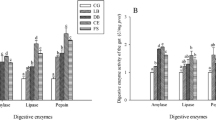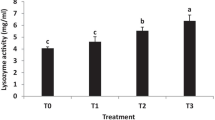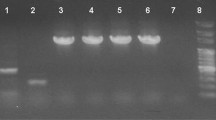Abstract
The aims of this study were to evaluate the effects of Lactococcus lactis subsp. lactis on the growth, intestinal microbiota, digestive enzyme activity, and disease resistance of Litopenaeus vannamei. Diets containing four different concentrations of L. lactis (0 [basal diet], 106, 107, and 108 CFU g−1) were fed to white shrimps L. vannamei (average weight 5.89 ± 0.36 g) for 8 weeks. At the end of the feeding trial, shrimps were immersed in Caspian Seawater (10.8 ppt) contaminated with 106 CFU ml−1 pathogenic V. anguillarum for 2 h. Results revealed that growth rate, survival, and body protein level were increased with dietary supplementation of L. lactis. The activities of digestive enzymes (cellulose, lipase, amylase, and protease) were significantly higher in the groups fed with diets containing 107 or 108 CFU g−1 L. lactis than those in the control. The Lactobacillus and Bacillus counts were higher (P < 0.05) in the intestine of shrimps fed with L. lactis-supplemented diets. In addition, higher level of L. lactis supplementation decreased the Vibrio counts. Moreover, L. vannamei fed diet supplemented with 108 CFU g−1 of L. lactis exhibited significantly the highest hematocyte count and post-challenge survival rate (79.2 %). Collectively, these results suggest that dietary supplementation of L. lactis subsp. lactis at 108 CFU g−1 can promote growth performance, digestive enzyme activity, and disease resistance of L. vannamei.

Similar content being viewed by others
References
FAO (2015) The state of world fisheries and aquaculture (SOFIA) 2015. FAO Fisheries and Aquaculture Department, Rome
Wu CC, Chang YP, Wang JJ, Liu CH, Wong SL, Jiang CM, Hsieh SL (2015) Dietary administration of Gynura bicolor (Roxb. Willd.) DC water extract enhances immune response and survival rate against Vibrio alginolyticus and white spot syndrome virus in white shrimp Litopeneaus vannamei. Fish Shellfish Immunol 42:25–33
Vieira FN, Pedrotti FS, Neto CCB, Mouriño JLP, Beltrame E, Martins ML (2007) Lactic-acid bacteria increase the survival of marine shrimp, Litopenaeus vannamei, after infection with Vibrio harveyi. Brazilian J Oceanography 55:251–255
Giri SS, Sen SS, Chi C, Kim HJ, Yun S, Park SC, Sukumaran V (2015) Effect of guava leaves on the growth performance and cytokine gene expression of Labeo rohita and its susceptibility to Aeromonas hydrophila infection. Fish Shellfish Immunol 46:217–224
Zokaeifar H, Balcázar JL, Saad CR, Kamarudin MS, Sijam K, Arshad A, Nejat N (2012) Effects of Bacillus subtilis on the growth performance, digestive enzymes, immune gene expression and disease resistance of white shrimp, Litopenaeus vannamei. Fish Shellfish Immunol 33:683–689
Kongnum K, Hongpattarakere T (2012) Effect of Lactobacillus plantarum isolated from digestive tract of wild shrimp on growth and survival of white shrimp (Litopenaeus vannamei) challenged with Vibrio harveyi. Fish Shellfish Immunol 32:170–177
Giri SS, Sukumaran V, Oviya M (2013) Potential probiotic Lactobacillus plantarum VSG3 improves the growth, immunity, and disease resistance of tropical freshwater fish, Labeo rohita. Fish Shellfish Immunol 34: 660–666
Nayak SK (2010) Probiotics and immunity: a fish perspective. Fish Shellfish Immunol 29:2–14
Ninawe AS, Selvin J (2009) Probiotics in shrimp aquaculture: avenues and challenges. Crit Rev Microbiol 35:43–66
Ajitha S, Sridhar M, Sridhar N, Singh ISB, Varghese V (2004) Probiotic effects of lactic acid bacteria against Vibrio alginolyticus in Penaeus (Fennero penaeus) Indicus (H. Milne Edwards). Asian Fisheries Sc 17:71–80
Chiu CH, Guu YK, Lui CH, Pan TM, Cheng W (2007) Immune response and gene expression in white shrimp, Litopenaeus vannamei, induced by Lactobacillus plantarum. Fish Shellfish Immunol 23:364–377
Soccol CR, de Souza Vandenberghe LP, Spier MR, Medeiros ABP, Yamaguishi CT, De Dea LJ, Pandey A, Thomaz-Soccol V (2010) The potential of probiotics: a review. Food Technol Biotechnol 48:413–434
Maeda M, Shibata A, Biswas G, Korenaga H, Kono T, Itami T, Sakai M (2014) Isolation of lactic acid bacteria from kuruma shrimp (Marsupenaeus japonicus) intestine and assessment of immunomodulatory role of a selected strain as probiotic. Mar Biotechnol 16:181–192
Dash G, Raman RP, Pani Prasad K, Makesh M, Pradeep MA, Sen S (2014) Evaluation of Lactobacillus plantarum as feed supplement on host associated microflora, growth, feed efficiency, carcass biochemical composition and immune response of giant freshwater prawn, Macrobrachium rosenbergii (de Man, 1879). Aquaculture 432:225–236
Li K, Zheng T, Tian Y, Xi F, Yuan J, Zhang G, Hong H (2007) Beneficial effects of Bacillus licheniformis on the intestinal microflora and immunity of the white shrimp, Litopenaeus vannamei. Biotechnol Lett 29:525–530
Austin B, Austin DA (2007) Bacterial fish pathogens, diseases of farmed and wild fish. Springer Praxis Publishing, Chichester
Heo WS, Kim YR, Kim EY, Bai SC, Kong IS (2013) Effects of dietary probiotic, Lactococcus lactis subsp. lactis I2, supplementation on the growth and immune response of olive flounder (Paralichthys olivaceus). Aquaculture 376–379:20–24
AOAC (2005) Official Methods of Analysis of the Association of Official Analytical Chemists. Arlington, Virginia
Ziaei-Nejad S, Rezaei MH, Takami GA, Lovett DL, Mirvaghefi A-R, Shakouri M (2006) The effect of Bacillus spp. bacteria used as probiotics on digestive enzyme activity, survival and growth in the Indian white shrimp Fenneropenaeus indicus. Aquaculture 252:516–524
Shyne Anand PS, Kohli MPS, Kumar S, Sundaray JK, Dam Roy S, Venkateshwarlu G, Sinha A, Pailan GH (2014) Effect of dietary supplementation of biofloc on growth performance and digestive enzyme activities in Penaeus monodon. Aquaculture 418–419:108–115
Wang X, Li H, Zhang X, Li Y, Ji W, Xu H (2000) Microbial flora in the digestive tract of adult penaeid shrimp (Penaeus chinensis). J Ocean Univ China 30:493–498
Wang Y, FU L, LIN J (2012) Probiotic (Bacillus coagulans) cells in the diet benefit the white shrimp Litopenaeus vannamei. J Shellfish Res 31:855–860
Merrifield DL, Burnard D, Bradley G, Davies SJ, Baker RTM (2009) Microbial community diversity associated with the intestinal mucosa of farmed rainbow trout (Oncoryhnchus mykiss Walbaum). Aquaculture Res 40:1064–1072
Marchesi JR, Sato T, Weightman AJ, Martin TA, Fry JC, Hiom SJ, Wade WG (1998) Design and evaluation of useful bacterium-specific PCR primers that amplify genes coding for bacterial 16S rRNA. Appl Environ Microbiol 64:795–799
Dees PM, Ghiorse WC (2001) Microbial diversity in hot synthetic compost as revealed by PCR-amplified rRNA sequences from cultivated isolates and extracted DNA. FEMS Microbiol Ecol 35:207–216
Sapcharoen P, Pengpipat S (2013) Effects of the probiotic Bacilus subtilis (BP11and BS11) on the growth and survival of Pacific white shrimp, Litopenaeus vannamei. Aquaculture Nutr 19:946–954
Balcazar JL, Rojas-Luna T, Cunningham DP (2007) Effect of the addition of four potential probiotic strains on the survival of pacific white shrimp (Litopenaeus vannamei) following immersion challenge with Vibrio parahaemolyticus. J Invertebrate Pathol 96:147–150
Wang YB (2007) Effect of probiotics on growth performance and digestive enzyme activity of the shrimp Penaeus vannamei. Aquaculture 269:259–264
Castex M, Chim L, Pham D, Lemaire P, Wabete N, Nicolas JL (2008) Probiotic P. acidilactici application in shrimp Litopenaeus stylirostris culture subject to vibriosis in New Caledonia. Aquaculture 275:182–193
Tovar D, Zambonino J, Cahu C, Gatesoupe FJ, Vazquez-Juarez R, Lesel R (2002) Effect of live yeast incorporation in compound diet on digestive enzyme activity in sea bass (Dicentrarchus labrax) larvae. Aquaculture 204:113–123
Thompson FL, Abreu PC, Cavalli R (1999) The use of microorganisms as food source for Penaeus paulensis larvae. Aquaculture 174:139–153
Verschuere L, Rombaut G, Sorgeloos P, Verstraete W (2000) Probiotics bacteria as biological control agents in aquaculture. Microbiol Mol Biol Rev 64:655–671
Gram L, Melchiorsen J, Spanggaard B, Huber I, Nielsen TF (1999) Inhibition of Vibrio anguillarum by Pseudomonas fluorescens AH2, a possible probiotic treatment of fish. Appl Environ Microbiol 65:969–973
Boonthai T, Vuthiphandchai V, Nimrat S (2011) Probiotic bacteria effects on growth and bacterial composition of black tiger shrimp (Penaeus monodon). Aquaculture Nutr 17:634–644
Sugita H, Matsuo N, Shibuya K, Deguchi Y (1996) Production of antibacterial substances by intestinal bacteria isolated from coastal crab and fish species. J Marine Biotechnol 4:220–223
Ringø E, Myklebustd R, Mayhewe TM, Olsen RE (2007) Bacterial translocation and pathogenesis in the digestive tract of larvae and fry. Aquaculture 268:251–264
Gullian M, Rodríguez J (2002) Immunostimulant qualities of probiotic bacteria. Global Aquaculture Advocates 5:52–54
Sakata T (1990) Microflora in the digestive tract of fish and shellfish. In: Lesel R (ed) Microbiology in Poecilotherms. Elsevier, Amsterdam, pp. 171–176
Vaseeharan B, Ramasamy P (2003) Control of pathogenic Vibrio spp. by Bacillus subtilis BT23, a possible probiotic treatment for black tiger shrimp Penaeus monodon. J Appl Microbiol 36:83–87
Acknowledgments
This study was funded by the Iranian Fisheries Research Organization (Tehran, Iran) and Sari Agricultural Sciences and Natural Resources University.
Author information
Authors and Affiliations
Corresponding author
Ethics declarations
Conflict of Interest
The authors declare that they have no conflict of interest.
Rights and permissions
About this article
Cite this article
Adel, M., El-Sayed, AF.M., Yeganeh, S. et al. Effect of Potential Probiotic Lactococcus lactis Subsp. lactis on Growth Performance, Intestinal Microbiota, Digestive Enzyme Activities, and Disease Resistance of Litopenaeus vannamei . Probiotics & Antimicro. Prot. 9, 150–156 (2017). https://doi.org/10.1007/s12602-016-9235-9
Published:
Issue Date:
DOI: https://doi.org/10.1007/s12602-016-9235-9




